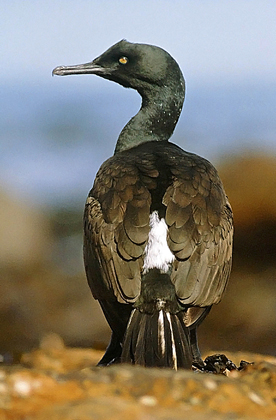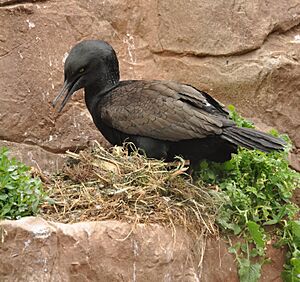Bank cormorant facts for kids
Quick facts for kids Bank cormorant |
|
|---|---|
 |
|
| Conservation status | |
| Scientific classification | |
| Genus: |
Phalacrocorax
|
| Species: |
neglectus
|
 |
|
| resident range | |
The bank cormorant (Phalacrocorax neglectus), also called Wahlberg's cormorant, is a medium-sized cormorant. It is a special bird because it lives only along the coasts of Namibia and western South Africa. These cormorants stay close to the ocean. They rarely go more than 15 kilometers (about 9 miles) offshore.
Contents
What Does the Bank Cormorant Look Like?
The bank cormorant is a strong, heavy bird. It grows to about 75 centimeters (30 inches) long. Most of its body is black, with a shiny bronze look. However, its wings are a dark brown color.
Adult bank cormorants have a small tuft of feathers on their heads. They also usually have a white patch near their tail, called a rump. Their pale eyes stand out against their black faces. Young birds have dark eyes instead.
Where Do Bank Cormorants Live and What Do They Eat?
Bank cormorants are expert divers. They hunt for food underwater. Their favorite food is the cape rock lobster (Jasus lalandii). These lobsters live in kelp forests. So, you will often find bank cormorants near these underwater kelp beds.
They also eat other types of crustaceans and fish. A common fish they hunt is the bearded goby (Sufflogobius bibarbatus).
How Do Bank Cormorants Raise Their Young?
Bank cormorants can lay eggs at any time of the year. They usually lay two or three eggs. These eggs are a chalky-white color. The parents build their nests using seaweed and guano (bird droppings).
Why Are Bank Cormorants in Danger?
The number of bank cormorants has been dropping quickly in recent years. This is a big worry for scientists. There are a few reasons why their numbers are going down.
One reason is commercial fishing. People catch a lot of the bearded goby fish. This fish is an important food source for the cormorants. When there are fewer fish, it's harder for the cormorants to find enough to eat.
Another problem is that humans disturb their nesting areas. When people get too close to their nests, the birds can get scared and leave their eggs or chicks.
Also, the number of kelp gulls has grown. This is partly because gulls find food easily from human activities. Kelp gulls are predators. They often eat the eggs and chicks of bank cormorants.
Today, there are probably only about 4,000 bank cormorants left in the world. The most important places where they live are Mercury Island and Ichaboe Island in Namibia. Protecting these areas is very important for the future of the bank cormorant.



